Meal prep is the practice of preparing key elements of dishes or full recipes ahead of time․ It involves portioning meals for convenience and efficiency․
This approach helps manage time, supports healthy eating, and reduces food waste, making it a popular choice for busy individuals seeking balanced nutrition․
1․1 What is Meal Prep?
Meal prep, short for meal preparation, involves planning, shopping, and preparing meals in advance to save time and ensure healthy eating․ It often includes portioning ingredients or full recipes for future meals, making it a convenient option for busy individuals․ The goal is to streamline cooking, reduce food waste, and maintain balanced nutrition throughout the week․
1․2 Importance of Meal Prep in Modern Life
Meal prep is essential in modern life for saving time, reducing food waste, and staying organized․ It helps individuals manage busy schedules, promotes healthy eating, and supports budgeting․ By prepping meals, people can avoid last-minute fast food and ensure balanced nutrition․ This practice also reduces stress and encourages a healthier lifestyle, making it a valuable tool for maintaining overall well-being in today’s fast-paced world․
Benefits of Meal Prep
Meal prep saves time, reduces food waste, and promotes healthy eating․ It aids in budgeting, supports a balanced diet, and enhances overall lifestyle efficiency and well-being․
2․1 Time-Saving Strategies
Meal prep streamlines cooking by allowing batch preparation and portioning․ This reduces daily cooking time, enabling quick meal assembly․ Planning meals in advance ensures efficient grocery shopping and minimizes food decision fatigue․ By prepping ingredients or entire meals, individuals save hours weekly, making it ideal for busy schedules․
2․2 Cost Efficiency and Budgeting
Meal prep enhances cost efficiency by reducing food waste and allowing bulk purchases․ Planning meals ensures ingredients are fully utilized, avoiding excess buying․ Budgeting benefits include reduced dining out expenses and smarter grocery shopping․ Portion control also helps prevent overeating, further optimizing resource use and savings․
2․3 Health and Nutrition Benefits
Meal prep promotes healthy eating by allowing control over ingredient quality and portion sizes․ It encourages balanced nutrition, reduces reliance on processed foods, and helps maintain dietary goals․ Prepping nutrient-dense meals fosters better eating habits, supports weight management, and enhances overall well-being․ This approach ensures consistent nutrient intake, benefiting long-term health and energy levels․
2․4 Reducing Food Waste
Meal prep helps minimize food waste by ensuring ingredients are used before expiring․ Planning meals and creating grocery lists prevent overbuying․ Prepping in portions allows for better tracking of food consumption, reducing leftovers that might go to waste․ This mindful approach encourages creativity in using up remaining ingredients, fostering sustainability and responsible food management․
By organizing meals, individuals can avoid throwing away unused items, contributing to a more eco-friendly lifestyle․
How to Plan Your Meals
Meal planning involves setting goals, creating a weekly schedule, listing groceries, and selecting recipes to save time and money effectively while ensuring balanced nutrition․
3․1 Setting Your Goals and Preferences
Start by identifying your dietary goals, such as weight loss or improved nutrition, and consider any preferences or restrictions, like vegetarian diets․
Assess your schedule, budget, and cooking skills to create realistic meal plans that align with your lifestyle, ensuring meals are both enjoyable and achievable․
3․2 Creating a Weekly Meal Schedule
Plan your meals for the week by listing breakfast, lunch, dinner, and snacks for each day․ Consider your schedule, ingredient availability, and dietary preferences when selecting recipes․
Ensure variety by rotating protein sources, vegetables, and whole grains․ Balance meals to meet nutritional needs and keep things interesting․ Adjust the plan as needed to accommodate changes or leftovers, ensuring flexibility while staying organized and efficient․
3․3 Selecting Recipes for Prep
Choose recipes that are simple, use common ingredients, and can be cooked in bulk․ Opt for dishes with overlapping components to reduce shopping trips and waste․ Ensure recipes align with your dietary goals and preferences, offering balanced nutrition․ Consider meals that reheat well and maintain flavor over several days․ This approach ensures variety and keeps meal prep enjoyable and sustainable․
Keep a bank of trusted recipes for easy reference, ensuring they fit your schedule and skill level․ Experiment with new ideas to avoid monotony and stay motivated in your meal prep journey․
Grocery Shopping Tips
Effective grocery shopping involves planning, list-making, and budgeting․ Buy in bulk for staples and fresh for perishables, ensuring you avoid waste and save money consistently․
4․1 Making a Grocery List
A well-organized grocery list is essential for efficient shopping․ Start by checking what you already have at home to avoid duplicates․ Categorize items by store sections (e․g․, produce, dairy) to streamline your shopping process․ Include quantities needed to ensure you buy enough without overstocking․ Stick to your list to avoid impulse purchases and stay within budget․ This approach reduces waste and saves time․
4․2 Buying in Bulk vs․ Fresh Ingredients
Buying in bulk can save money and reduce shopping trips, but it’s best for non-perishable items like grains, legumes, and canned goods․ Fresh ingredients, such as fruits and vegetables, should be purchased in smaller quantities to maintain quality and prevent spoilage․ Balancing bulk purchases with fresh items ensures a cost-effective and nutritious meal prep strategy while minimizing waste․
4․3 Staying Within Budget
Staying within budget requires careful planning and smart shopping․ Start by creating a detailed grocery list based on your meal plan to avoid impulse buys․ Opt for seasonal produce and affordable protein sources like beans or eggs․ Consider buying in bulk for non-perishable items and use coupons or apps for discounts․ Tracking expenses helps ensure you stay on target while enjoying nutritious, prepped meals․
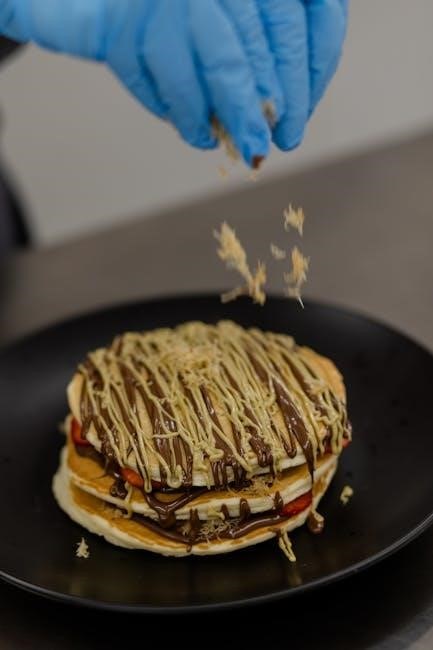
Preparing Meals in Advance
Preparing meals in advance streamlines cooking, organizes portions, and ensures consistent nutrition throughout the week․ It involves cooking, portioning, and storing meals to save time and effort․
5․1 Cooking and Portioning
Cooking and portioning are key steps in meal prep, ensuring meals are ready to eat․ This method involves preparing large batches of ingredients like grains, proteins, and vegetables, then dividing them into individual portions․ Proper portion control helps maintain balanced nutrition and prevents overeating․ Using reusable containers keeps meals fresh and organized for grab-and-go convenience․ This approach also simplifies mealtime decisions, saving time and effort during busy days․
5․2 Storage Containers and Organization
Using high-quality, airtight containers is essential for maintaining freshness and organization in meal prep․ Choose leak-proof, microwave-safe options to store prepped meals․ Label containers with contents and dates for easy identification․ Stackable designs save space in refrigerators or freezers․ Separate ingredients or fully cooked meals in different containers to simplify meal assembly․ Proper organization ensures meals stay fresh longer and reduces food waste, making meal prep more efficient and enjoyable․
5․3 Safety Tips for Storing Prepped Meals
Ensure all prepped meals are cooled to room temperature before refrigerating to prevent bacterial growth․ Store meals in airtight, shallow containers to allow even cooling․ Label containers with dates and contents for easy monitoring․ Keep refrigerated meals below 40°F and frozen meals at 0°F․ Consume refrigerated meals within 3-4 days and frozen meals within 3-4 months․ Always reheat meals to 165°F for food safety before consumption․
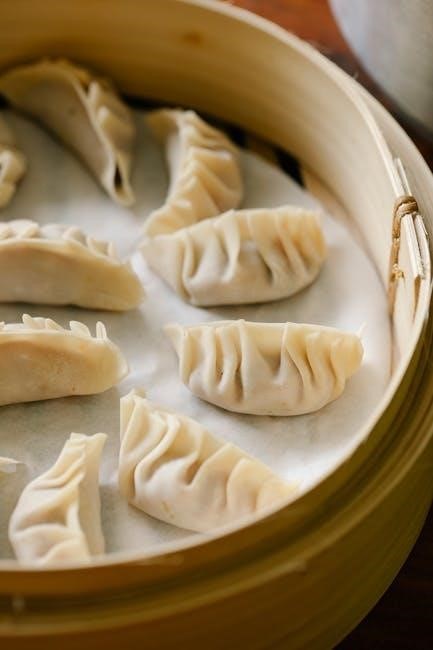
Healthy Recipes for Meal Prep
Discover nutritious meal prep recipes for breakfast, lunch, snacks, and desserts․ Use fresh ingredients and simple cooking methods to create balanced, delicious meals for grab-and-go convenience․
6․1 Breakfast Ideas
Meal prep breakfast ideas include overnight oats, breakfast burritos, and muffins․ Prepare ingredients like scrambled eggs, avocado, and whole grains in advance․ Use mason jars for overnight oats or portion out smoothie ingredients․ These options are quick, nutritious, and customizable to suit any dietary preference․ Add fresh fruits or nuts for extra flavor and texture, ensuring a healthy start to your day․
6․2 Lunch and Dinner Options
Meal prep for lunch and dinner can include grilled chicken, roasted vegetables, and quinoa salads․ Prepare batch-cooked proteins like turkey or tofu, and portion them with mixed greens or brown rice․ Slow-cooker recipes, such as stews or chili, are ideal for advance prep․ Use marinades for added flavor and store meals in airtight containers for up to five days․ This ensures variety and convenience for busy schedules․
6․3 Snacks and Desserts
Prepping snacks and desserts ensures healthy choices and reduces last-minute purchases․ Opt for energy balls made with oats and nuts, fruit salads, or yogurt parfaits․ For desserts, prepare batch-cooked muffins, protein bars, or chia pudding․ Portion them into individual containers for easy grabs․ These options are nutrient-dense, satisfying, and align with dietary preferences, making meal prep seamless and enjoyable for all meals of the day․
Time-Saving Meal Prep Strategies
Efficient meal prep involves batch cooking, one-pot meals, and slow cooker recipes․ These methods minimize time spent in the kitchen while maximizing flavor and nutrition․
7․1 Batch Cooking
Batch cooking involves preparing large quantities of a single ingredient or dish to use across multiple meals․ This strategy saves time by reducing daily cooking tasks and streamlines meal prep․ It’s ideal for staples like grains, proteins, or roasted vegetables, which can be portioned and stored for later use․ Planning and executing batch cooking sessions ensures efficiency and reduces food waste, making it a cornerstone of effective meal prep routines․
7․2 One-Pot Meals
One-pot meals are a time-saving strategy for meal prep, allowing all ingredients to cook together in a single vessel․ This method minimizes cleanup and reduces cooking time, making it ideal for busy schedules․ Recipes like stir-fries, soups, and skillet dinners are perfect for one-pot prep․ They also help maintain flavor consistency and simplify portioning for grab-and-go meals, enhancing the efficiency of meal prep routines and ensuring delicious results every time․
7․3 Using a Slow Cooker
A slow cooker is a valuable tool for meal prep, offering hands-off cooking that fits seamlessly into busy schedules․ Simply add ingredients in the morning, and return to a ready-to-eat meal․ This method is ideal for hearty dishes like stews, chili, and roasts․ It ensures tender, flavorful results with minimal effort, making it a cost-effective and efficient way to prepare nutritious meals for the week ahead․
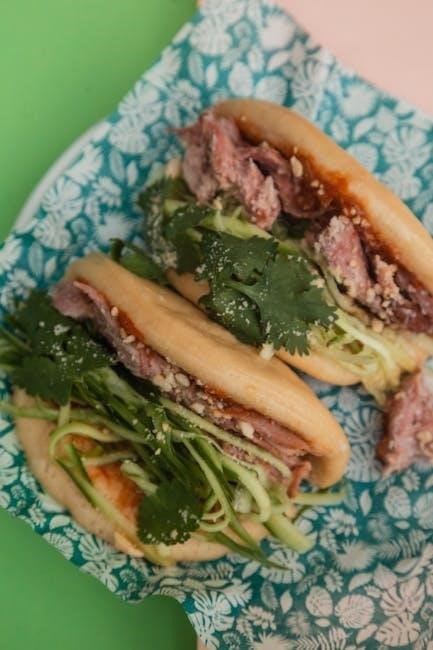
Tools and Resources for Meal Prep
Essential tools include meal prep containers, planners, and appliances like slow cookers․ PDF guides and templates provide structured plans for organizing and executing meal prep effectively․
8․1 Essential Kitchen Tools
A well-equipped kitchen is vital for meal prep․ Essential tools include sharp knives, cutting boards, measuring cups, and multi-use appliances like slow cookers and rice cookers․ Storage containers, both glass and plastic, are crucial for keeping prepped meals fresh․ A food scale and portion control tools help in dividing meals accurately․ Reusable silicone bags and ice trays are handy for organizing ingredients․ Investing in durable, versatile tools streamlines the meal prep process, saving time and effort․
8․2 Meal Prep Containers
Meal prep containers are essential for storing prepped meals safely and efficiently․ Choose durable, airtight containers to maintain freshness and prevent leaks․ Glass containers are ideal for visibility and reheating, while plastic ones are lightweight and portable․ Look for containers with compartments to separate ingredients․ Reusable silicone bags are great for snacks and sauces․ Properly sized containers help portion control and keep meals organized for grab-and-go convenience․
8․3 PDF Guides and Templates
PDF guides and templates are invaluable tools for meal prep organization․ They provide structured meal plans, grocery lists, and recipe templates to streamline the process․ Digital guides offer customizable options, while printable templates help track progress․ These resources ensure consistency, save time, and keep meal prep efforts organized․ They are perfect for beginners and experienced preppers alike, offering clear guidance and inspiration for balanced, delicious meals․
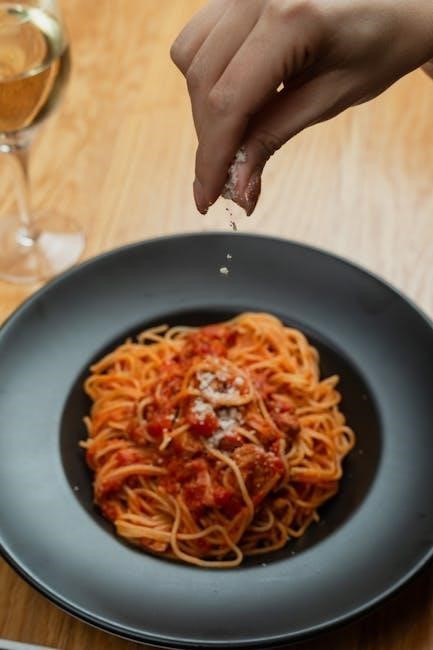
Common Mistakes to Avoid
Common mistakes include overpreparing, leading to waste, and lack of variety, causing boredom․ Improper storage and portioning can also reduce meal quality and safety․
9․1 Overpreparing
Overpreparing is a common mistake that leads to food waste and spoilage․ Cooking too much or preparing meals too far in advance can result in uneaten portions․ This not only wastes ingredients but also defeats the purpose of meal prep, which is to save time and resources․ To avoid this, plan portions carefully and store meals properly to maintain freshness and reduce waste․
9․2 Lack of Variety
Lack of variety is a common pitfall in meal prep, leading to boredom and dissatisfaction․ Preparing the same meals repeatedly can make the experience monotonous and less enjoyable․ To avoid this, incorporate diverse recipes and ingredients into your meal prep routine․ Rotate proteins, vegetables, and grains to keep meals interesting․ Experimenting with new flavors and cuisines can also help maintain enthusiasm and ensure a balanced diet without additional effort or time․
9․3 Improper Storage
Improper storage is a common mistake that can lead to spoilage and foodborne illness․ Using inadequate containers or failing to label meals can result in disorganization and wasted food․ Always use airtight, leak-proof containers to maintain freshness and prevent cross-contamination․ Label meals with dates to ensure you consume them within safe time frames․ Proper storage is essential for maintaining meal quality and safety․
Meal Prep for Special Diets
Meal prep adapts to various dietary needs, offering customizable plans for vegetarian, vegan, keto, and weight loss regimes, ensuring nutrition and structure without compromising taste or variety․
10․1 Vegetarian and Vegan Meal Prep
Vegetarian and vegan meal prep focuses on plant-based ingredients, ensuring Protein-rich and nutrient-dense meals․ Plan around legumes, grains, and fresh vegetables to maintain variety and satisfaction․ Incorporate recipes like lentil curries, quinoa bowls, and roasted veggie salads․ Use leftovers creatively to minimize waste and stay organized with reusable containers for grab-and-go meals․
10․2 Keto and Low-Carb Meal Prep
Keto and low-carb meal prep emphasizes high-fat, moderate-protein, and minimal-carbohydrate ingredients․ Focus on meats, fish, eggs, avocado, and low-carb vegetables like spinach and cauliflower․ Plan meals such as keto casseroles, chicken salads, and stuffed bell peppers․ Portion control is crucial, and using airtight containers ensures freshness․ This approach helps maintain ketosis and supports weight management while keeping meals flavorful and satisfying․
10․3 Meal Prep for Weight Loss
Meal prep for weight loss focuses on portion-controlled, nutrient-dense meals․ Plan calorie-conscious recipes, balance macronutrients, and incorporate whole foods like lean proteins, vegetables, and whole grains․ Use a meal prep template to track intake and stay consistent․ Preparing meals in advance helps avoid unhealthy choices and supports sustainable weight management by promoting healthy habits and reducing overeating․
Inspiration and Motivation
Success stories and seeing progress can inspire consistency in meal prep․ Staying motivated involves setting achievable goals and celebrating small victories along the way․
11․1 Success Stories
Many individuals share inspiring stories of how meal prep transformed their lives․ Busy professionals and parents often highlight time-saving benefits, while others emphasize improved health and reduced food waste․ These success stories motivate others to adopt meal prep, showcasing its versatility and positive impact on daily routines and long-term goals․
11․2 Staying Motivated
Staying motivated with meal prep involves setting realistic goals, celebrating small achievements, and experimenting with new recipes․ Tracking progress and planning meals in advance can reinforce commitment․ Incorporating variety in dishes and sharing experiences with others also helps maintain enthusiasm․ Over time, the benefits of meal prep, such as improved health and time savings, become intrinsic motivators to sustain the practice․
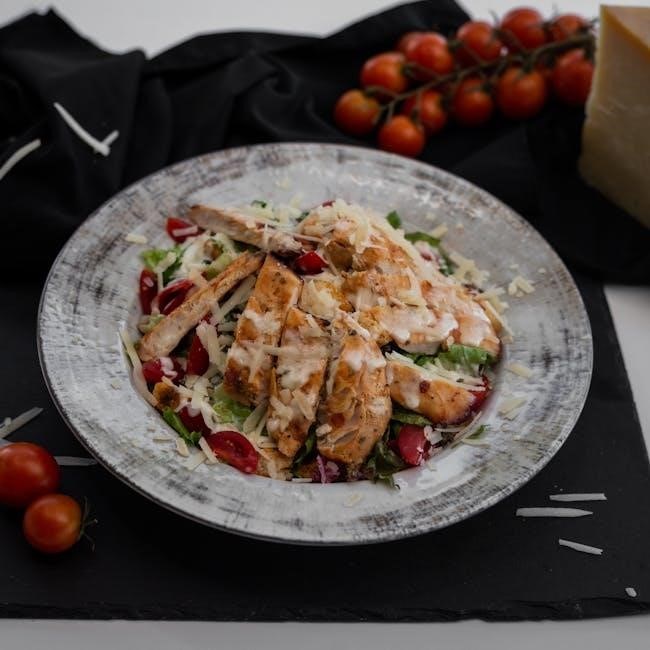
Future Trends in Meal Prep
Future trends include technology integration, such as AI meal planning and smart kitchen tools, alongside a growing emphasis on sustainable practices and meal prep subscription services․
12․1 Meal Prep Services
Meal prep services are becoming increasingly popular, offering pre-portioned ingredients and ready-to-eat meals delivered to your door․ These services cater to various dietary needs, such as keto, vegan, or low-carb diets, providing convenience and time-saving solutions for busy individuals․ They often include customizable meal plans, promoting healthy eating and reducing food waste․ Such services are particularly appealing to those seeking structured meal prep without the hassle of planning and grocery shopping․
12․2 Technology and Meal Prep
Technology has revolutionized meal prep through innovative tools and apps that streamline planning, grocery shopping, and cooking․ Digital meal planners and recipe generators, like ChatGPT, provide tailored meal ideas and grocery lists․ Smart kitchen gadgets, such as slow cookers and meal prep containers, enhance efficiency․ Additionally, AI-driven platforms offer personalized nutrition plans, making meal prep more accessible and customizable for diverse dietary needs․
Meal prep is a practical approach to saving time and promoting healthy eating․ By planning and preparing meals in advance, individuals can reduce food waste and maintain balanced nutrition․ This method supports various lifestyles and dietary needs, making it a sustainable choice for long-term health and convenience․ Start your meal prep journey today for a healthier, organized tomorrow!
13․1 Final Thoughts
Meal prep is a powerful tool for modern lifestyles, offering time-saving, cost-efficient, and nutritious solutions․ By planning and preparing meals in advance, individuals can maintain healthy habits, reduce waste, and enjoy balanced nutrition․ Whether for personal goals or family needs, meal prep fosters organization and sustainability, making it a valuable practice for long-term wellness and convenience․ Embrace meal prep to transform your relationship with food and streamline your daily routine․
13․2 Call to Action
Ready to transform your meal prep journey? Download our comprehensive meal prep PDF guide to unlock proven strategies, delicious recipes, and expert tips․ Start planning, prepping, and enjoying nutritious meals with ease․ Visit our website today and take the first step toward a healthier, more organized you—your future self will thank you! Begin your meal prep adventure now and start cooking smarter today․
